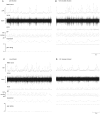Sympathetic Responses to Noxious Stimulation of Muscle and Skin
- PMID: 27445972
- PMCID: PMC4927631
- DOI: 10.3389/fneur.2016.00109
Sympathetic Responses to Noxious Stimulation of Muscle and Skin
Abstract
Acute pain triggers adaptive physiological responses that serve as protective mechanisms that prevent continuing damage to tissues and cause the individual to react to remove or escape the painful stimulus. However, an extension of the pain response beyond signaling tissue damage and healing, such as in chronic pain states, serves no particular biological function; it is maladaptive. The increasing number of chronic pain sufferers is concerning, and the associated disease burden is putting healthcare systems around the world under significant pressure. The incapacitating effects of long-lasting pain are not just psychological - reflexes driven by nociceptors during the establishment of chronic pain may cause serious physiological consequences on regulation of other body systems. The sympathetic nervous system is inherently involved in a host of physiological responses evoked by noxious stimulation. Experimental animal and human models demonstrate a diverse array of heterogeneous reactions to nociception. The purpose of this review is to understand how pain affects the sympathetic nervous system by investigating the reflex cardiovascular and neural responses to acute pain and the long-lasting physiological responses to prolonged (tonic) pain. By observing the sympathetic responses to long-lasting pain, we can begin to understand the physiological consequences of long-term pain on cardiovascular regulation.
Keywords: blood pressure; cutaneous pain; muscle pain; muscle sympathetic nerve activity; nociception; skin sympathetic nerve activity.
Figures




Similar articles
-
[Pathophysiology of low back pain and the transition to the chronic state - experimental data and new concepts].Schmerz. 2001 Dec;15(6):413-7. doi: 10.1007/s004820100002. Schmerz. 2001. PMID: 11793144 German.
-
Responses of adrenal sympathetic nerve activity and catecholamine secretion to cutaneous stimulation in anesthetized rats.Neuroscience. 1984 May;12(1):289-99. doi: 10.1016/0306-4522(84)90154-4. Neuroscience. 1984. PMID: 6462449
-
Individual differences in the cardiovascular responses to tonic muscle pain: parallel increases or decreases in muscle sympathetic nerve activity, blood pressure and heart rate.Exp Physiol. 2012 Oct;97(10):1084-92. doi: 10.1113/expphysiol.2012.066191. Epub 2012 May 11. Exp Physiol. 2012. PMID: 22581744
-
Differential activation of sympathetic discharge to skin and skeletal muscle in humans.Acta Physiol Scand Suppl. 1997;639:1-32. Acta Physiol Scand Suppl. 1997. PMID: 9421582 Review.
-
Autonomic dysreflexia: Somatosympathetic and viscerosympathetic vasoconstrictor responses to innocuous and noxious sensory stimulation below lesion in human spinal cord injury.Auton Neurosci. 2018 Jan;209:71-78. doi: 10.1016/j.autneu.2017.07.003. Epub 2017 Jul 13. Auton Neurosci. 2018. PMID: 28728939 Review.
Cited by
-
Insulin potentiates the response to capsaicin in dorsal root ganglion neurons in vitro and muscle afferents ex vivo in normal healthy rodents.J Physiol. 2022 Feb;600(3):531-545. doi: 10.1113/JP282740. Epub 2022 Jan 13. J Physiol. 2022. PMID: 34967443 Free PMC article.
-
Depression and Endothelial Dysfunction in Psoriatic Arthritis: Is There Any Possible Relationship?Front Med (Lausanne). 2021 Aug 27;8:669397. doi: 10.3389/fmed.2021.669397. eCollection 2021. Front Med (Lausanne). 2021. PMID: 34513861 Free PMC article.
-
Effectiveness and safety of subthreshold vibration over suprathreshold vibration in treatment of muscle fatigue in elderly people.World J Clin Cases. 2023 May 26;11(15):3434-3443. doi: 10.12998/wjcc.v11.i15.3434. World J Clin Cases. 2023. PMID: 37383890 Free PMC article. Review.
-
Autonomic modulation with mindfulness-based stress reduction in chronic kidney disease: a randomized controlled trial.J Physiol. 2025 Jan;603(2):489-505. doi: 10.1113/JP287321. Epub 2024 Dec 18. J Physiol. 2025. PMID: 39693497 Clinical Trial.
-
Asystole Following Jaw Thrust Maneuver: A Case Report.Cureus. 2024 Oct 8;16(10):e71077. doi: 10.7759/cureus.71077. eCollection 2024 Oct. Cureus. 2024. PMID: 39512957 Free PMC article.
References
-
- Guyton A, Hall J, Schmitt W, Gruliow R, Norwitz A. Textbook of Medical Physiology. (Vol. 10). Sydney: W.B. Saunders Company; (1956).
-
- Sherrington CS. The Integrative Action of the Nervous System. New Haven, CT: Yale University Press; (1906). 411 p.
-
- Price DD. Psychological and Neural Mechanisms of Pain. Isle of Skye: Raven Press; (1988).
Publication types
LinkOut - more resources
Full Text Sources
Other Literature Sources

